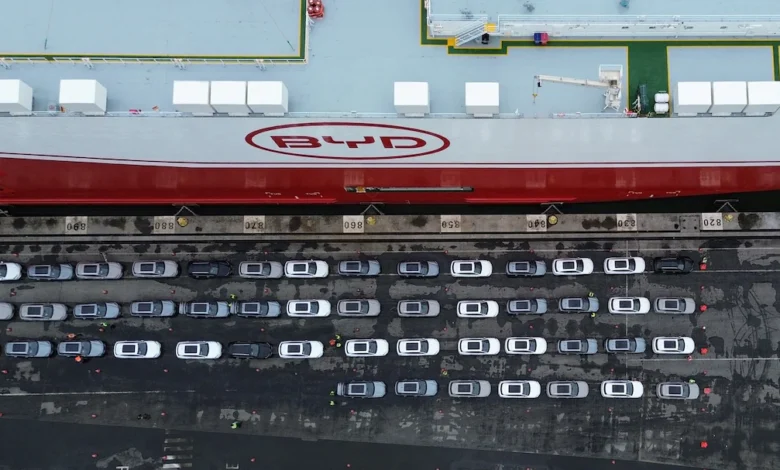World’s Largest Car Carrier Docks in Brazil Amid Growing Chinese Auto Presence

The world’s largest car-carrying vessel recently completed its maiden voyage, docking at the port of Itajaí, Brazil, late last month. The ship, with a capacity equivalent to 20 football fields of vehicles, marked another milestone in China’s growing automotive footprint in Latin America.
At the center of this development is BYD, China’s leading manufacturer of electric and plug-in hybrid vehicles. The automaker continues to expand its global reach, with Brazil emerging as a key destination, according to a Reuters analysis of shipping data and corporate disclosures. The May delivery represented the fourth such shipment by BYD this year, accounting for an estimated 22,000 vehicles.
Brazil, the sixth-largest vehicle market globally, presents both opportunities and challenges for international manufacturers. While consumers are showing growing interest in environmentally friendly vehicles, industry stakeholders and labor unions in Brazil have expressed concern over the impact of rising Chinese imports on domestic production and employment.
According to Brazil’s national auto association, imports of China-built vehicles are projected to increase by nearly 40% in 2025, reaching approximately 200,000 units—around 8% of total light-vehicle registrations.
Labour unions, such as IndustriALL Brasil, have urged the Brazilian government to accelerate a planned increase in tariffs on electric vehicle imports, currently scheduled to gradually rise from 10% to 35% by 2026. “Countries around the world started closing their doors to the Chinese, but Brazil didn’t,” said Aroaldo da Silva, president of IndustriALL Brasil, during an industry briefing.
In response to industry lobbying, Brazil’s Ministry of Development, Industry & Foreign Trade confirmed to Reuters that it is reviewing proposals to bring forward the tariff hike. A spokesperson explained that the gradual increase in duties was designed to provide manufacturers with a transition window to develop or expand local production.
BYD has not commented on the concerns raised but continues to utilize Brazil’s current duty-free import quotas for plug-in hybrid and battery-electric vehicles, which allow up to $395 million in tax-exempt imports through mid-2025. This policy has encouraged automakers to prioritize shipments to Brazil while the incentives remain in effect.
Analysts suggest that this front-loaded export strategy aligns with broader trends in China’s automotive sector. Over the past five years, a surplus of new vehicles has fueled an export boom, enabling China to surpass Japan in 2023 as the world’s largest auto exporter. Facing stiff tariffs in Europe and the U.S., Chinese automakers are looking to Latin America—and Brazil in particular—as strategic growth markets.
Brazil’s government had previously lifted EV import tariffs in 2015 to boost electric mobility. However, a 10% tariff was reintroduced in 2023, with a plan for semi-annual increases culminating in a 35% rate by 2026.
As Brazil balances environmental policy, consumer demand, and economic protectionism, the coming months will likely determine whether it tightens its trade policy or continues to serve as an open door for China’s growing electric vehicle ambitions.
‘EXCESS OF IMPORTS’
BYD’s export strategy hinges on the carmaker being able to continue growing shipments without triggering resistance from local authorities. But industry representatives in Brazil have grown increasingly worried that BYD’s plans to begin domestic vehicle production are being pushed off.
In 2023, government officials cheered BYD’s plan to purchase a former Ford plant in the state of Bahia, viewing it as a way to create manufacturing jobs and spur the country’s green transition. But an investigation into labor abuses on the construction site pushed back its timeline for “fully functional” production to December 2026, local officials said in May.
Another Chinese automaker, GWM, opens new tab, also delayed by more than a year its plan to start making cars at a former Mercedes-Benz (MBGn.DE), opens new tab plant. The Brazilian government expects the plant to begin operating this year.
“We support the arrival of new brands in Brazil to produce, promote the components sector, create jobs and bring new technologies,” Igor Calvet, president of ANFAVEA, told Reuters. “But from the moment that an excess of imports causes lower investment in production in Brazil, that worries us.”
Da Silva of IndustriALL said his confederation of unions had not heard of any local supplier relationships being developed or contracts being signed for the BYD plant, as would normally be expected 18 months from the start of production.
“Even if the factory is here – what value is it really adding if the components, development, and technology is all from abroad?” da Silva said.
BYD did not respond to a request for comment on its supplier network.
President Lula da Silva’s left-wing Workers Party government is scrambling to protect jobs and the environment as it aims to both revive Brazil’s industrial economy and restore its green credentials ahead of hosting the COP30 global climate summit this November.
Still, the country’s nascent green-car movement leans on Chinese imports, which account for more than 80% of Brazil’s electric-car sales, according to Brazil’s EV association, ABVE.
The country has abundant mineral resources including lithium and other key ingredients to make EV batteries. But the infrastructure to produce all the necessary components for electric cars does not exist yet, said Ricardo Bastos, director of government relations at GWM Brazil and president of ABVE.
GWM, which bought a factory in Brazil in 2021 with capacity for 50,000 cars a year and is due to start producing its Haval H6 SUV there this July, is in talks with around 100 Brazil-based suppliers on setting up contracts, Bastos told Reuters.
“This year, imported cars will coexist alongside cars produced in Brazil,” Bastos said.





